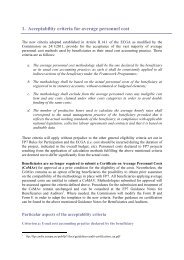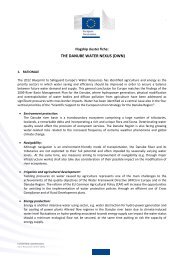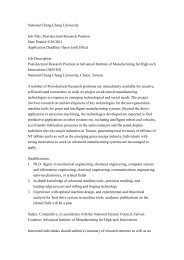Guide to Research and Innovation Strategies for Smart Specialisation
Guide to Research and Innovation Strategies for Smart Specialisation
Guide to Research and Innovation Strategies for Smart Specialisation
Create successful ePaper yourself
Turn your PDF publications into a flip-book with our unique Google optimized e-Paper software.
Key enabling technologies<br />
Why should Key Enabling Technologies be part of smart specialisation?<br />
The Commission defined micro/nanoelectronics, pho<strong>to</strong>nics, nanotechnology, industrial<br />
biotechnology, advanced materials <strong>and</strong> advanced manufacturing systems as the six key<br />
enabling technologies of Europe. KETs are knowledge-intensive <strong>and</strong> associated with high<br />
R&D intensity, rapid innovation cycles, high capital expenditure <strong>and</strong> highly-skilled<br />
employment. They enable process, goods <strong>and</strong> service innovation throughout the economy <strong>and</strong><br />
are of systemic relevance. They are multidisciplinary, cutting across many technology areas<br />
with a trend <strong>to</strong>wards convergence <strong>and</strong> integration. KETs can assist technology leaders in other<br />
fields <strong>to</strong> capitalise on their research ef<strong>for</strong>ts. 93<br />
Key Enabling Technologies (KETs) have been singled out by the European Commission in<br />
the proposal <strong>for</strong> the new Cohesion Policy as one of the investment priorities of the European<br />
Regional Development Fund (ERDF) as a relevant investment <strong>for</strong> the smart growth of<br />
regions 94 .<br />
KETs are seen as the route <strong>to</strong> new <strong>and</strong> better products <strong>and</strong> processes, capable of generating<br />
economic growth <strong>and</strong> employment <strong>and</strong> strengthening the competitiveness of the EU economy.<br />
They bear enormous market potentials. In the coming four years, the growth rates of each of<br />
these technologies range between 6% - 15%. The overall global market volume will most<br />
likely increase from 840 Bio. USD <strong>to</strong> 1300 Bio. USD. Even more important are their spillover<br />
effects on industry users from various industrial value chains, including suppliers <strong>and</strong><br />
downstream sec<strong>to</strong>rs. KETs can spur innovation, increase productivity, give rise <strong>to</strong> new<br />
applications <strong>and</strong> help tackle societal challenges.<br />
The particularity of a KETs-related innovation policy is that it engages ac<strong>to</strong>rs along different<br />
industrial value chains across the EU – including technology developers (universities,<br />
research <strong>and</strong> technology organisations), start-ups, SMEs <strong>and</strong> manufacturers. Consequently, a<br />
KETs-focused innovation policy allows most industrial sec<strong>to</strong>rs <strong>and</strong> any region <strong>to</strong> become<br />
involved <strong>and</strong> benefit from the EU's overall KETs approach, whatever its specialisation <strong>and</strong><br />
focus areas. The Commission is in the process of aligning <strong>and</strong> coordinating EU policies in<br />
favour of a coherent strategy on KETs, which will open up great opportunities <strong>for</strong> regions.<br />
Regions should indeed analyse those opportunities, either as an emerging sec<strong>to</strong>r, or as a<br />
means <strong>to</strong> modernise traditional sec<strong>to</strong>rs.<br />
Barriers <strong>and</strong> Challenges<br />
The key challenge <strong>for</strong> regions will be <strong>to</strong> identify their respective economic niches <strong>and</strong><br />
competitive advantages in KETs development <strong>and</strong> deployment activities. Regions should be<br />
aware of key guiding principles, such as: what are the industrial needs with regard <strong>to</strong><br />
technologies? Who are the main ac<strong>to</strong>rs <strong>and</strong> potential cus<strong>to</strong>mers of these activities? Is there a<br />
business case in terms of market exploitation?<br />
93 (COM(2009) 512)<br />
94 See Article 5 (1) (c) ERDF: 'supporting technological <strong>and</strong> applied research, pilot lines, early product<br />
validation actions, advanced manufacturing capabilities <strong>and</strong> first production in Key Enabling Technologies <strong>and</strong><br />
diffusion of general purpose technologies'.<br />
86

















